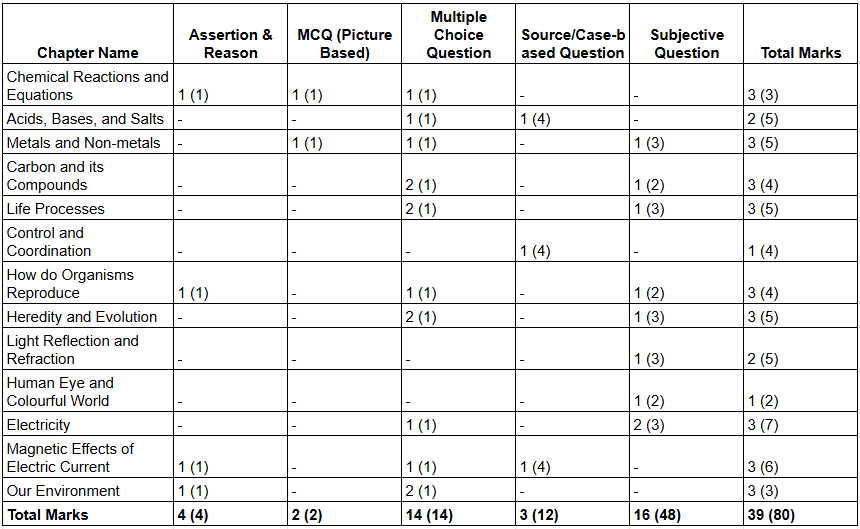CBSE Class 10 students are gearing up for their board exams, and one of the most crucial resources for effective preparation is understanding the blueprint of the Science exam. This blog post provides a comprehensive breakdown of the CBSE Class 10 Science Blueprint for the 2024-25 academic year, giving students an in-depth understanding of question distribution, chapter-wise weightage, and tips for acing the exam going to be conducted on February 20, 2025.
Why Is the CBSE Blueprint Important?
The blueprint serves as a roadmap for students, helping them focus on high-weightage topics and specific question types. It categorizes marks allocation across chapters and question types such as multiple-choice questions (MCQs), assertion and reasoning, case-based questions, and subjective questions.
By aligning your preparation with the blueprint, you can:
- Strategically prioritize topics.
- Familiarize yourself with the exam pattern.
- Boost your confidence for the big day.
Understanding the Blueprint
The blueprint reveals the following key aspects of the exam:
- Unit-wise Weightage:
- Chemical Substances - Nature and Behaviour: 25 marks
- World of Living: 25 marks
- Natural Phenomena: 12 marks
- Effects of Current: 13 marks
- Natural Resources: 5 marks
- Question Types:
- Assertion & Reason: 4 marks (1 mark for each correct answer)
- MCQs: 14 marks (1 mark for each correct answer)
- Picture-Based MCQs: 2 marks (1 mark for each correct answer)
- Source/Case-Based Questions: 12 marks (Varying marks for each question)
- Subjective Questions: 48 marks (Varying marks for each question)
CBSE Class 10 Science Blueprint 2024-25: Chapter-Wise Marks Distribution
Here is the detailed blueprint for CBSE Class 10 Science for the academic year 2024-25. The marks are divided into five types of questions: Assertion & Reason, Picture-Based MCQs, Multiple Choice Questions, Source/Case-based Questions, and Subjective Questions.
| Chapter Name | Assertion & Reason | MCQ (Picture Based) | Multiple Choice Question | Source/Case-based Question | Subjective Question | Total Marks |
|---|---|---|---|---|---|---|
| Chemical Reactions and Equations | 1 (1) | 1 (1) | 1 (1) | - | - | 3 (3) |
| Acids, Bases, and Salts | - | - | 1 (1) | 1 (4) | - | 2 (5) |
| Metals and Non-metals | - | 1 (1) | 1 (1) | - | 1 (3) | 3 (5) |
| Carbon and its Compounds | - | - | 2 (1) | - | 1 (2) | 3 (4) |
| Life Processes | - | - | 2 (1) | - | 1 (3) | 3 (5) |
| Control and Coordination | - | - | - | 1 (4) | - | 1 (4) |
| How do Organisms Reproduce | 1 (1) | - | 1 (1) | - | 1 (2) | 3 (4) |
| Heredity and Evolution | - | - | 2 (1) | - | 1 (3) | 3 (5) |
| Light Reflection and Refraction | - | - | - | - | 1 (3) | 2 (5) |
| Human Eye and Colourful World | - | - | - | - | 1 (2) | 1 (2) |
| Electricity | - | - | 1 (1) | - | 2 (3) | 3 (7) |
| Magnetic Effects of Electric Current | 1 (1) | - | 1 (1) | 1 (4) | - | 3 (6) |
| Our Environment | 1 (1) | - | 2 (1) | - | - | 3 (3) |
| Total Marks | 4 (4) | 2 (2) | 14 (14) | 3 (12) | 16 (48) | 39 (80) |

Key Takeaways from the Blueprint
- High-Weightage Chapters:
- Electricity (7 marks)
- Magnetic Effects of Electric Current (6 marks)
- Acids, Bases, and Salts (5 marks)
- Metals and Non-metals (5 marks)
- Life Processes (5 marks)
- Assertion & Reasoning Questions: These questions test critical thinking and conceptual clarity. Prepare thoroughly for chapters like "How Do Organisms Reproduce" and "Magnetic Effects of Electric Current."
- Case-Based Questions: Expect application-based questions from chapters like "Acids, Bases, and Salts" and "Control and Coordination."
- Subjective Questions: With 48 marks allocated to subjective questions, practice detailed answers for high-weightage topics like "Electricity," "Carbon and its Compounds," and "Heredity and Evolution."
Also Read: CBSE Class 10 English (Language & Literature) Blueprint 2025
Tips to Prepare for the CBSE Class 10 Science Exam
- Understand the Weightage: Focus more on chapters with higher marks. Revise critical topics like "Electricity," "Life Processes," and "Magnetic Effects of Electric Current."
- Practice Past Papers: Solve previous year’s question papers and sample papers to get an idea of the question pattern.
- Conceptual Clarity: Avoid rote learning. Understand the "why" and "how" behind scientific phenomena.
- Diagram Practice: Chapters like "Human Eye and Colourful World" and "Life Processes" often include diagram-based questions. Practice drawing and labeling diagrams neatly.
- Time Management: Allocate specific time slots for practicing different question types, such as MCQs, case-based questions, and long answers.
Conclusion
The CBSE Class 10 Science blueprint for 2024-25 is a crucial tool for strategic preparation. By focusing on high-weightage chapters and mastering various question types, you can boost your performance in the exam. Use this blueprint to plan your study schedule effectively, and don’t forget to revise regularly.
Stay tuned for more updates and resources to help you ace your CBSE board exams! If you found this post helpful, share it with your friends and fellow students.
Make the most of this detailed blueprint and ensure you are well-prepared for the CBSE Class 10 Science board exam! Good luck!
Note: This blueprint is based on general trends and may vary slightly from the actual exam paper.

Sir ,how did you know about that which type of questions will be asked from each chapter?
This blueprint is based on general trends and may vary slightly from the actual exam paper.
Ooo,okay sir
Sir is this blue print same as board and the marking skim too of 2025